TG-FTIR analysis of pyrolusite reduction by major biomass components☆
Yunfei Long ,Le Ruan ,Xiaoyan Lü ,Yiju Lü ,Jing Su ,Yanxuan Wen ,*
1 School of Chemistry and Chemical Engineering,Guangxi University,Nanning 530004,China
2 College of Chemistry and Bioengineering,Guilin University of Technology,Guilin 541004,China
Keywords:Pyrolusite Reduction Biomass Component TG-FTIR
ABSTRACT Pyrolusite reduction processes by three major biomass components cellulose,hemicelluloses and lignin,represented by CP,HP and LP,respectively,were investigated by thermogravimetric analyzer coupled with Fourier transforminfrared spectrometry(TG-FTIR).The ?esták-Berggren(SB)equation was used to evaluate the kinetics of reduction processes.TG analysis reveals that the main reduction processes occur at 250-410 °C,220-390 °C,and 190-410°C for CP,HP,and LP,respectively.FT-IR and XRD results indicate that various reducing volatiles(e.g.aldehydes,furans,ketones and alcohols)are produced fromthe pyrolysis with the three major components,which directly reduce MnO2 in ore to MnO.The processes are described by the SBequation with three parameters(m,n,p).Their non-zero values suggest that pyrolusite reduction is controlled by the diffusion of reducing gaseous products through an ash/inert layer associated with minerals.The apparent activation energies for pyrolusite reduction by CP,HP and LP are 40.48,25.70 and 40.10 kJ·mol-1,respectively.
1.Introduction
Manganese is widely used in many fields,such as steel production and preparation of dietary additives,fertilizers,cells and fine chemicals.Because of gradual depletion of high-grade manganese ores,many efforts have been made to meet the ever increasing demand for manganese by recovering it from low-grade pyrolusite.The stability of manganese oxide(MnO2)in pyrolusite under acid and alkaline oxidizing conditions enables manganese extraction from pyrolusite under reducing conditions.Generally,there are two major technical routes to reduce pyrolusite by hydrometallurgical and pyrometallurgical reductions[1].Hydrometallurgical reduction uses reducing agents(SO2,molasses,glucose,H2O2,FeSO4,etc.)to reduce manganese dioxide from the ores under acid medium[1,2],but this method is not widely applied in commercial practices because of its complex puri fication process and serious water-pollution hazards[2].Pyrometallurgical reduction with coal as reducing agent is a conventional technology for treating lowgrade pyrolusite[1,3],but it produces numerous pollutants,including smoke dust,oxysul fides,and nitrogen oxides[1,4].Moreover,itrequires a reaction temperature over 900°C,which is too high for most reactors[1,5-7].Thus it is highly important to develop a clean,energy-saving and environment-friendly route to reduce the low-grade pyrolusite.
Recently,the potential of biomass wastes,such as sawdust,straw,cornstalk,bagasse and bagasse pith,as reducing agent have been investigated to overcome above problems[8-14].Results show that biomass can reduce MnO2in ores at temperatures below 600°C with reduction higher than 95%.Cheng et al.[11]have reported that low-grade MnO2ores can be totally reduced by cornstalk biomass at 500°C.Yang et al.[12]and Long et al.[13]have found that low-grade pyrolusite can be completely reduced by bagasse at 450°C.Zhou et al.[14]have also reported thatpyrolusite can be reduced by bagasse pith at350°C.Biomass reduction is a zero emission process,because the amount of CO2produced during reduction is equal to that absorbed during biomass growth[15].Hence,biomass is an environment-friendly,energysaving,and low-cost reducing agent for reducing MnO2from ores.
A comprehensive understanding on the thermal reduction process and kinetics is necessary for ef ficient biomass reduction of pyrolusite.Fourier transformation infrared spectrometry(FT-IR)and pyrolysisgas chromatography/mass spectrometry(Py-GC/MS)results indicate that thermal reduction of pyrolusite is related to biomass pyrolysis[13,16].Based on the first-order reaction hypothesis,Coats-Redfern method[17]has been used to determine the activation energy of nonisothermal reduction of MnO2ore by biomass,such as straw,sawdust,wheat stalk and bamboo,and some valuable conclusions and insights have been obtained[18-20].However,investigation of kinetics for each biomass is impossible because of their wide variety.Therefore,a general kinetic equation is necessary to describe the reduction of pyrolusite by different biomass.
All types of biomass contain three major components,cellulose,hemicelluloses and lignin[21].Each component has differentmolecular structure and nature and different pyrolysis characteristics,and generates different gas products,resulting in different pyrolusite reduction behavior[22-25].Biomass reduction of low-grade pyrolusite ore can be considered as the superposition of the reduction behavior of the three major components.Therefore,elucidation of the reduction behavior of each component and their interactions is essential to better understand the reduction mechanism and obtain a general kinetic equation on reduction of pyrolusite.However,results on each biomass component and their interactions in the pyrolusite reduction are limited.
In this study,processes of pyrolusite thermal reduction by the three major components of biomass are investigated.The pyrolysis of each component and their effects on the pyrolusite reduction are analyzed by TG/DTG-FTIR experiments.The ?esták-Berggren(SB)equation with three parameters is used to describe the kinetic behavior of pyrolusite reduction.The information obtained in this study is useful to better understand the biomass reduction of pyrolusite and provides valuable insights in the development of general kinetic equation.
2.Materials and Methods
2.1.Materials
Pyrolusite was collected from Guangxi,China,containing Mn 22.01 wt%,Fe 11.16 wt%,SiO227.62 wt%,Al2O310.93 wt%,CaO 0.09 wt%,MgO 0.12 wt%,S 0.020 wt%,and P 0.181 wt%.The ore samples were crushed to 0.147 mm(100 mesh).Cellulose was purchased from Beijing Chemical Reagent Company(Beijing,China).Xylan(extracted from beech wood and often used as a representative compound for hemicelluloses)and lignin were obtained from Sigma-Aldrich Corp.(MO,USA).The cellulose,hemicellulose and lignin were mixed and tested without further treatments.Pyrolusite was mixed with cellulose,hemicellulose or lignin ata mass ratio of 10:1,based on the previous results[13].Pyrolusite reduction processes by cellulose,hemicellulose and lignin are labeled as CP,HP,and LP,respectively.
2.2.TG–FTIR
A thermogravimetric analyzer(Q50TGA,TA,DE,USA)was coupled with a FT-IR spectrophotometer(Nicolet6700,OMNIC)to investigate the mass loss and on-line evolution of gaseous products from the pyrolysis.In the TGA experiment,the sample was heated from room temperature to 800 °C at 20 °C·min-1under N2at a flow rate of 40 ml·min-1to maintain an inert atmosphere for decomposition.The FT-IR was connected to TG by a flow cell,which was heated to 180°C to prevent condensation of produced gas on the cell wall.The scanning range was set to be 600-4000 cm-1.Considering the time required for N2to flow and fill the spectrometer cell volume,the start time difference between FT-IR and TG is about 4 min.To reduce the in fluence of sample amount on IR absorption intensity,the mass of each sample was(15±0.05)mg.
2.3.XRD analysis
Ore samples before and after heating were characterized by powder X-ray diffraction(XRD,Rigaku model D/max-2500)to determine the mineralogical composition.The diffractogram obtained was identical to standard diffraction mineral patterns.
2.4.Kinetic model background
The kinetics of heterogeneous reaction processes is described as different equations by taking into account special features of their mechanisms.The reaction rate(dα/d t)can be expressed by conversion α.

When temperature increases at a constant ratenon-thermal kinetic equation of a process can be written as[26,27]

The kinetic function f(α)for a heterogeneous reaction depends on the reaction mechanism.The SB equation represents a generalized function to describe heterogeneous reaction kinetics and itis a powerfultool to deal with kinetic data by model- fitting methods[28-30]:

where m,n,and p are generally non-integer exponents.The SB equation with three parameters is commonly abbreviated as SB(m,n,p)equation.Differentvalues of m,n and p describe various probable mechanisms,as classi fied in Table 1.Therefore,the equation can describe the kinetics of complex heterogeneous reaction processes.
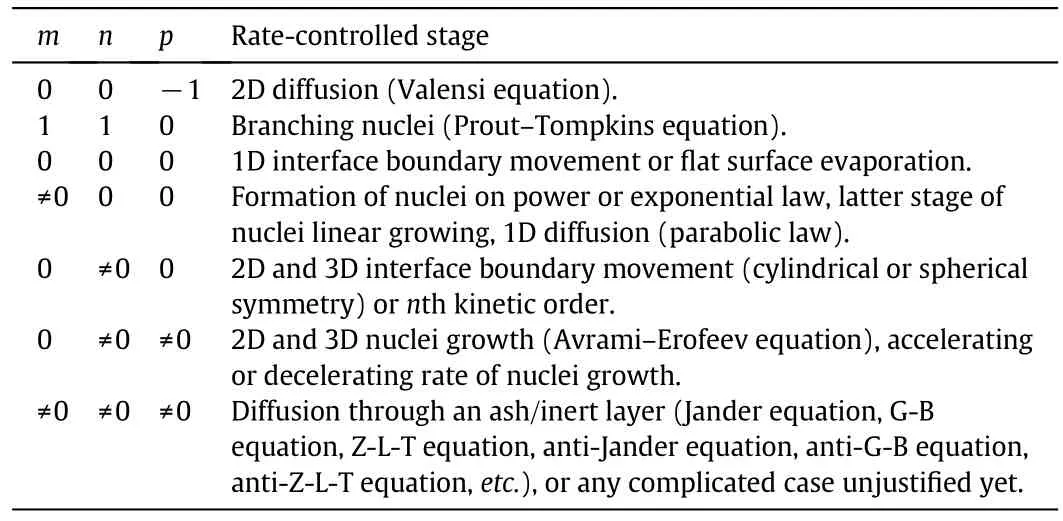
Table 1 Mechanism of rate-limiting stages using m,n and p values
Substitution of Eq.(3)into Eq.(2)gives the following general differential equation

Taking the logarithm of Eq.(4),the following equation is obtained.

3.Results and Discussion
3.1.Thermal analysis
TG/DTG experiments were conducted to measure the mass change during the pyrolysis of the three biomass components and the reduction of pyrolusite under N2at a 20 °C·min-1heating rate.Fig.1 shows these TG/DTG curves.Each pyrolysis process can be divided into three stages[31,32].In the first stage(below 200°C),mass is lost in sample drying and most of the moisture is released.The second stage involves fast thermal decomposition processes and contributes to the major mass loss.The last stage is high-temperature charring of the residue with minimal mass loss.In the second stage,decomposition processes of cellulose,hemicelluloses and lignin occur at 290-400,180-370,and 200-580°C,respectively.Compared with the narrow peaks of cellulose and hemicellulose,lignin has a wide mass-loss peak.Cellulose and lignin have a single peak,while hemicellulose presents two peaks.The maximum values of DTG curves(mass-loss rate)of cellulose,hemicellulose and lignin are achieved at about 360 °C,300 °C and 320°C,respectively.The differences in thermal decomposition processes indicate thatthe three major biomass components have different pyrolusite reduction characteristics.
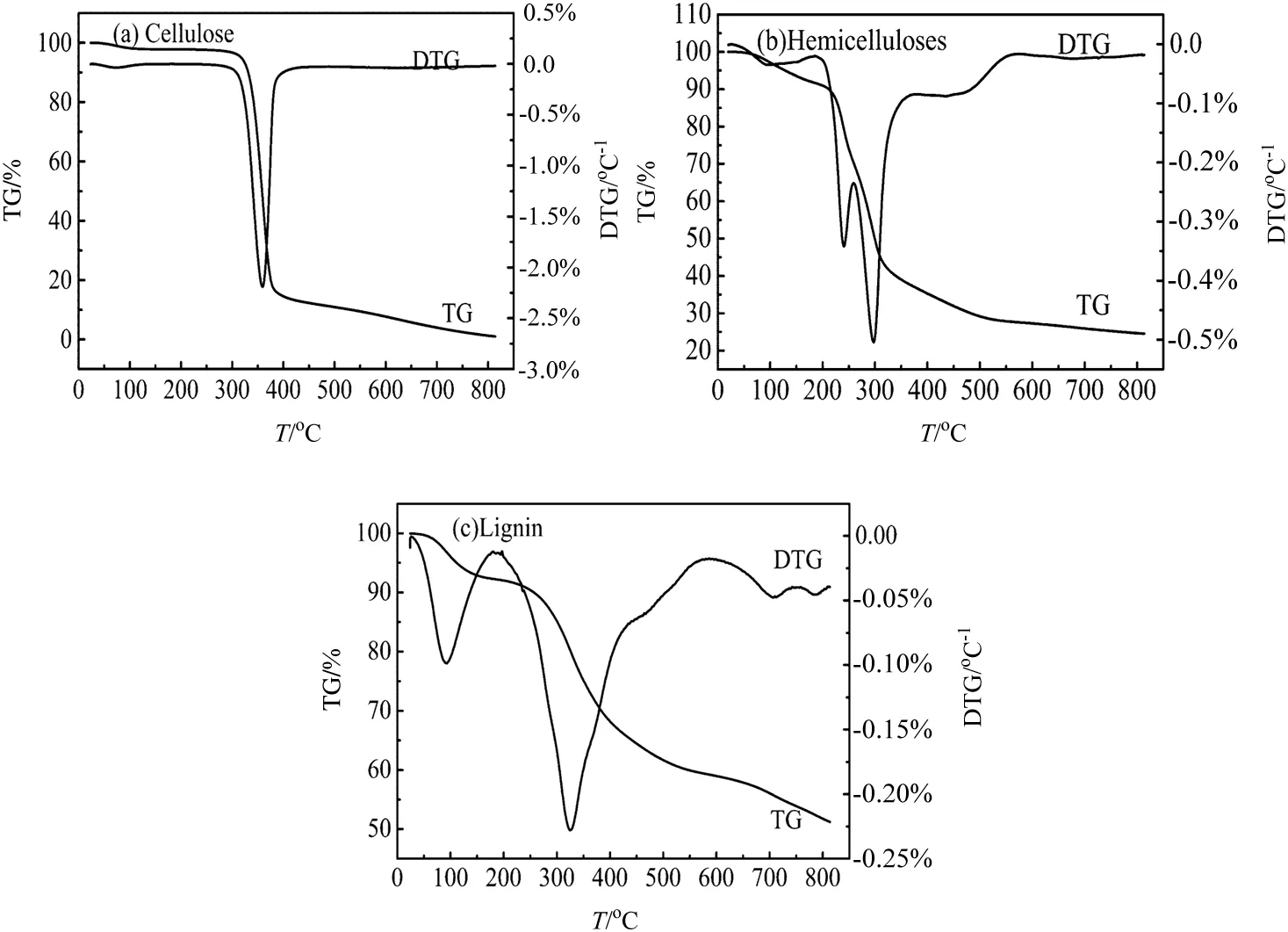
Fig.1.TG-DTG curves of three biomass components at heating rate of 20 °C·min-1.(a)Cellulose;(b)hemicelluloses;(c)lignin.
Fig.2 presents the mass-loss behavior of pyrolusite reduction by cellulose,hemicellulose and lignin,also with three stages.It indicates that pyrolusite reduction is related to the products released in the pyrolysis of the three components.The main mass-loss stages of CP,HP,and LP occur at 250-410 °C,220-390 °C and 190-410 °C,with their maximum values ofDTGcurves(mass-loss rate)atabout357 °C,295°C and 340 °C,respectively.CP begins to lose mass at about 250°C,earlier than that of cellulose[Fig.1(a)].HP presents only one peak,while hemicellulose has two peaks[Fig.1(b)].The temperature range ofLP issmallerthan thatof lignin[Fig.1(c)].These results suggest that pyrolusite has catalytic effects on the pyrolysis of cellulose,hemicellulose and lignin[33].
3.2.FT-IR analysis
Infrared spectrum is often used to distinguish functional groups of various inorganic and organic compounds from pyrolysis.A 3D infrared spectrum of evolution gases involves information on infrared absorbance,wave numbers,and time or temperature.Typical spectral outputs from TG-FTIR analysis on three biomass components and their mixtures with pyrolusite are shown in Figs.3 and 4.
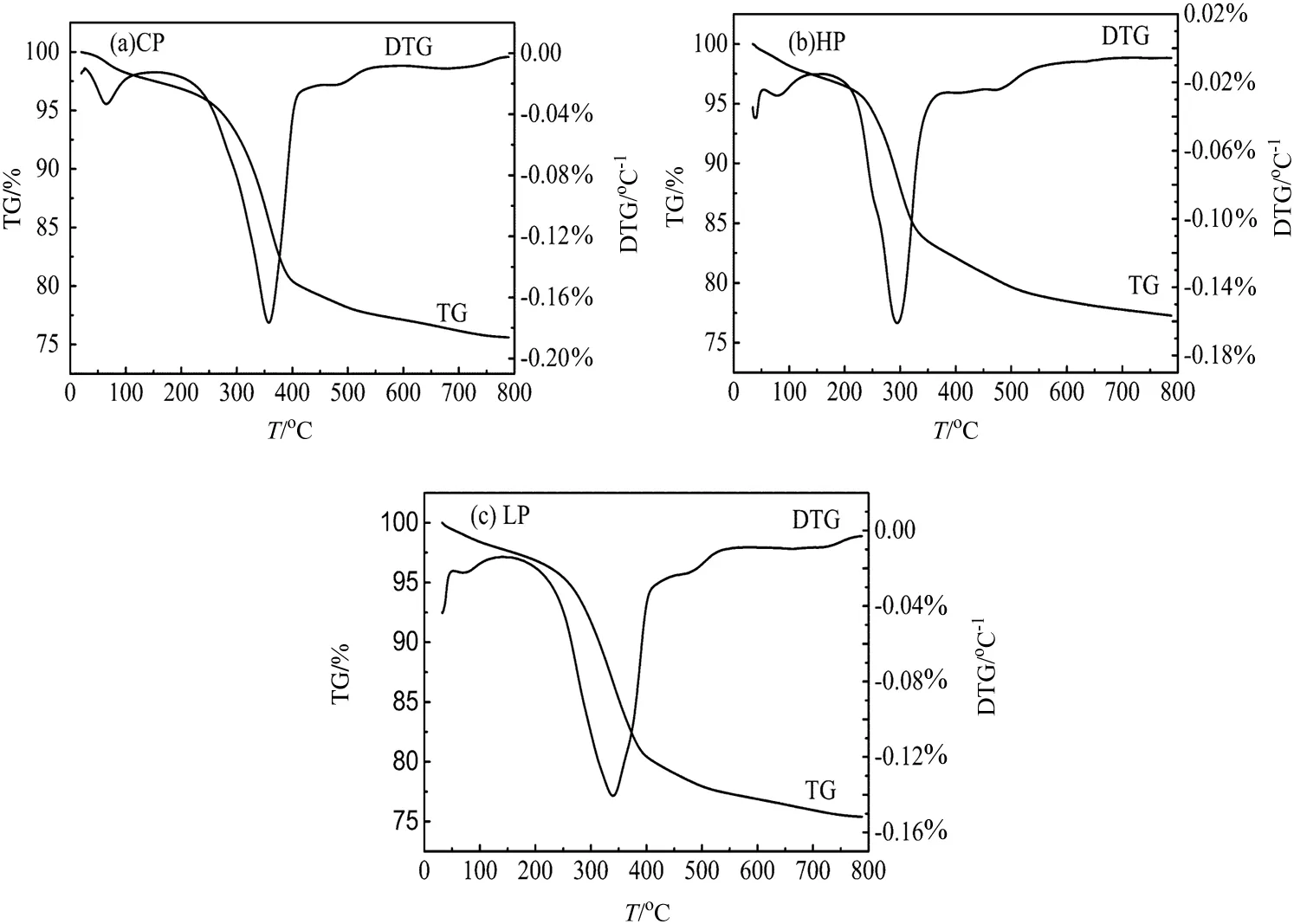
Fig.2.TG-DTG curves of major biomass components and pyrolusite mixtures at 20 °C·min-1.(a)CP;(b)HP;(c)LP.
As pyrolusite reduction progresses or temperature increases,concentrations of gaseous products increase until reaching the maximum.The gas products are concentrated at 15-21,11-20,11-27,13-21,11-20,and 10-22 min for cellulose,hemicellulose,lignin,CP,HP,and LP,respectively.The increase of gaseous product concentrations is due to the increase of pyrolysis rates of three biomass components and the reduction rates of three mixtures caused by the increase of reaction temperature.Large amounts of cellulose,hemicellulose or lignin are completely decomposed,and the pyrolusite is completely reduced by the gas products from the pyrolysis of the three biomass components within 21(cellulose and CP),20(hemicellulose and HP),27(lignin),or 22 min(LP),releasing several products.From the infrared spectrum,the change ofspectralintensity with respectto time is similarto the TG/DTG results as shown in Figs.1 and 2.These results show that most of the pyrolytic reactions of the three biomass components have vigorously commenced around the mass-loss peak.However,the gas products of the biomass components are more complicated than those fromthe pyrolusite reduction.

Fig.3.3D infrared spectrum of evolved gases during pyrolysis of three biomass components.(a)Cellulose;(b)hemicellulose;(c)lignin.
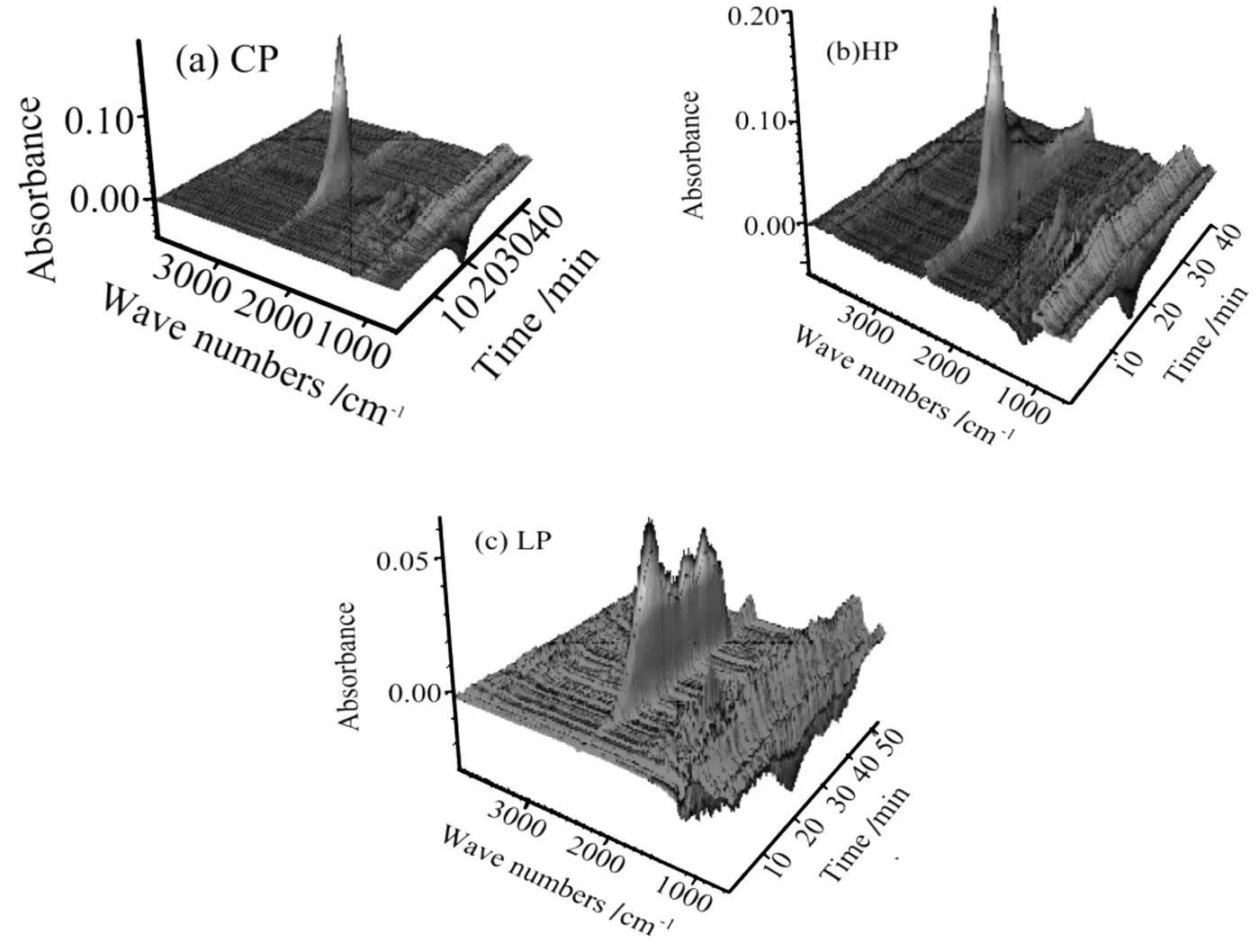
Fig.4.3D infrared spectrum of evolved gases during pyrolusite reduction by the three major biomass components.(a)CP;(b)HP;(c)LP.

Fig.5.Infrared spectrum of evolved gases during the pyrolysis of the three biomass components.(a)Cellulose;(b)hemicellulose;(c)lignin.
Fig.5 shows the FTIR spectra of the volatiles generated during the pyrolysis of three biomass components.The notable peaks at about 2300 cm-1are designated to CO2,and the bands at about 3700 and 2000 cm-1can be ascribed to H2O and CO,respectively.The release of CO2is mainly caused by the cracking and rearrangement of carbonyl and carboxyl groups,and CO is mainly released from the bond breaking of C-O-C and C=O[34].The spectral region of 2700-3200 cm-1represents C-H stretching and shows the formation of hydrocarbons,especially methane.The release of CH4is mainly caused by the cracking of methoxy(-O-CH3)and methylene[35].Absorption bands at about 1700 cm-1are assigned to C=O stretching from aldehydes,ketones and acids,which mainly appear in cellulose and hemicellulose pyrolysis[22].Aldehydes(such as formaldehyde)may form from the fragmentation of hydroxymethylene groups(-CH2OH)[34].Absorption bands at 1300-1500 cm-1are related to C-O-C bending and stretching on furans,phenols,ethers,or esters,which are the major gas products from lignin pyrolysis.The absorption peak at 1100 cm-1might be resulted from the stretching of-OH bonds on phenols or alcohols.Furthermore,the adsorption peaks between 900 and 600 cm-1mightbe associated to C-Hstretching for mono-and polycyclic,as wellas substituted aromatic groups.The IR spectra of the three biomass components reveal their unique pyrolysis characteristics to some extent,although they share some common functional groups.
The bands associated to CH4and CO stretching are not observed in Fig.6.Nevertheless,the peaks at about 2300-2400 cm-1are related to CO2.The peaks at about 1700,1500 and 1000 cm-1are associated to the bending and stretching of C=O,C-O-C and-OH bands,respectively.The main gas product in Fig.6 is CO2because of its relatively higherintensity than otherproducts,suggesting thatthe pyrolysis products of the biomass components react with pyrolusite and further decompose to CO2.
The FT-IR data in Figs.3-6 provide useful evidence on the formation of volatile organic species from the pyrolysis of biomass components and pyrolusite reduction.However,simultaneous evolution of several volatile compounds with similar chemical structures limits the identi fication of each single species by FT-IR spectral analyses.Detailed information on the organic compounds formed during the pyrolysis and reduction processes can be obtained from GC-MS analysis.Py-GC/MS is used to obtain some insights on the formation of volatile organic species fromthe pyrolysis ofbiomass components and pyrolusite reduction;the related results will be summarized elsewhere.
3.3.Kinetic analysis
Results from TG-FTIRanalyses presentcomplex pyrolusite reduction with biomass components,involving many reductive volatiles with different molecular structures and characteristics.To obtain kinetic equations for these complex reduction processes,α and dα/d t provided in Fig.7 are calculated from the data in Fig.2,and values of ln A,Ea/R,m,n and p are obtained by using multiple regression method.The fitting results are presented in Table 2.The correlation coef ficients(R2)for the three reduction processes are greater than 0.95,indicating that the reduction processes can be described by the SB(m,n,p)equation.The non-zero values of m,n and p suggest that pyrolusite reduction by the three biomass components is controlled by the diffusion of reducing gaseous products through an ash/inert solid layer.
The mineral composition of ore samples before and after heating is identi fied with XRD patterns as shown in Fig.8.Original ore consists of pyrolusite(MnO2),hematite(Fe2O3),and kaolinite,while its reduction products are mainly manganese oxide(MnO),hematite and kaolinite.Hence,the inert minerals(e.g.hematite,quartz,kaolinite),intermediates(e.g.Mn2O3and Mn3O4)[36,37])and final product(MnO)associated with pyrolusite possibly act as the ash/inert layers.
Based on the above analysis,pyrolusite reduction by the three biomass components can be divided to four steps:(1)thermal pyrolysis ofbiomass to release gaseous reducing volatiles,(2)diffusion ofgaseous reducing volatiles through ash/inert layer,(3)adsorption of volatiles onto pyrolusite particle surfaces,and(4)gradual reduction of MnO2in pyrolusite to MnO by adsorbed reducing gas atthe heating temperature and subsequent oxidation to CO2.
4.Conclusions
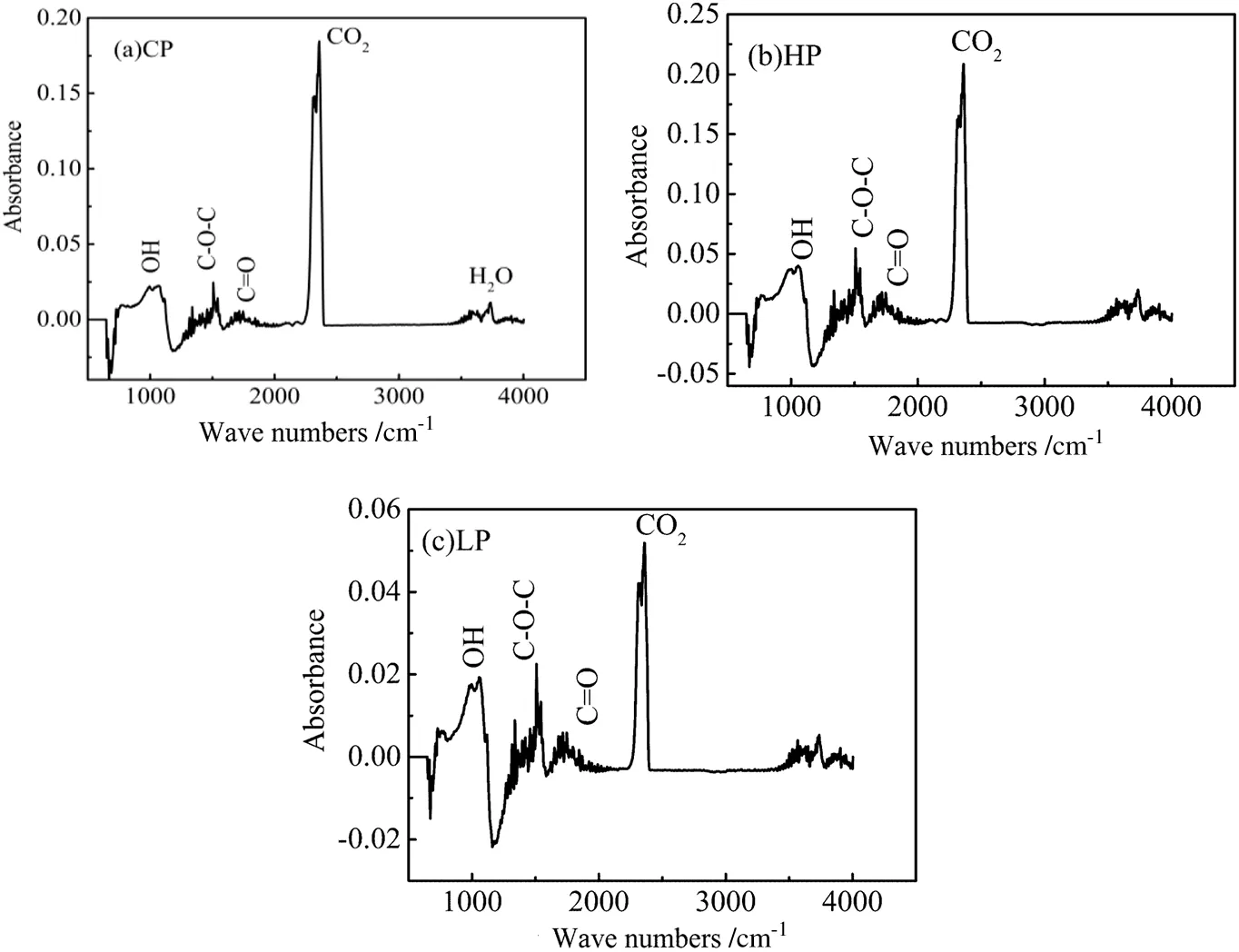
Fig.6.Infrared spectrum of evolved gases during pyrolusite reduction by three major biomass components.(a)CP;(b)HP;(c)LP.
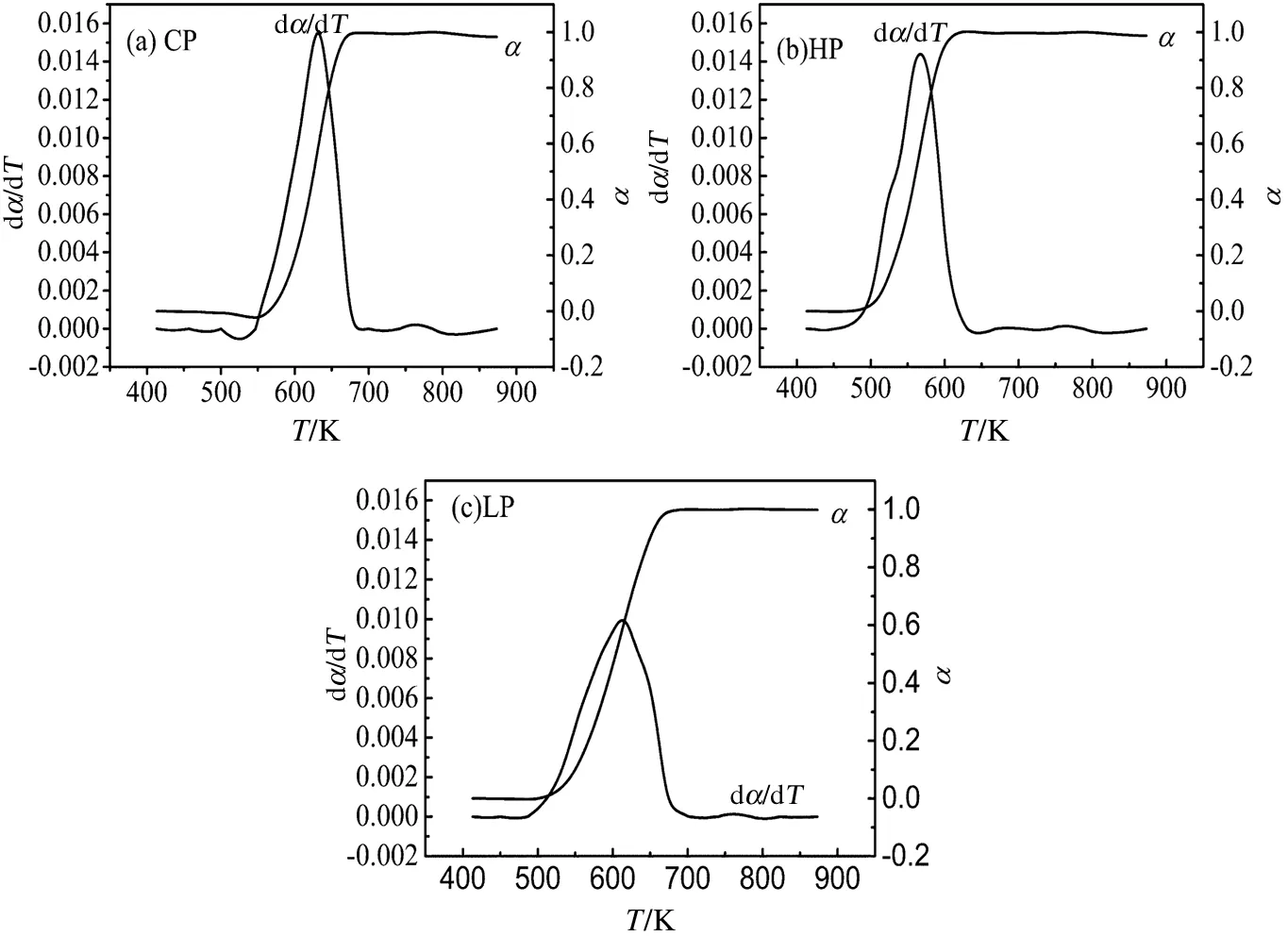
Fig.7.Conversion and rate curves for pyrolusite reduction by three biomass components.(a)CP;(b)HP;(c)LP.
The pyrolusite reduction by the three major biomass components(cellulose,hemicellulose and lignin)was investigated.The TG-FTIR results reveal that the main pyrolusite reduction by cellulose reduction of cellulose,hemicellulose and lignin occurred at 250-410°C,220-390 °C and 190-410 °C,respectively.FT-IR and XRD analyses indicate the production of various reducing volatiles(such as aldehydes,furans,ketones,and alcohols)from the pyrolysis ofcellulose,hemicellulose and lignin,which gradually reduce MnO2in the ore to MnO.The kineticanalyses show that pyrolusite reduction is controlled by the diffusion of volatiles through the ash/inert layer associated with minerals.The reduction processes can be described by the SB(m,n,p)equation with non-integer exponents.Apparent activation energies of pyrolusite reduction by cellulose,hemicellulose and lignin are 40.48,25.70,and 40.10 kJ·mol-1,respectively.

Table 2 Kinetic parameters obtained by SB(m,n,p)model
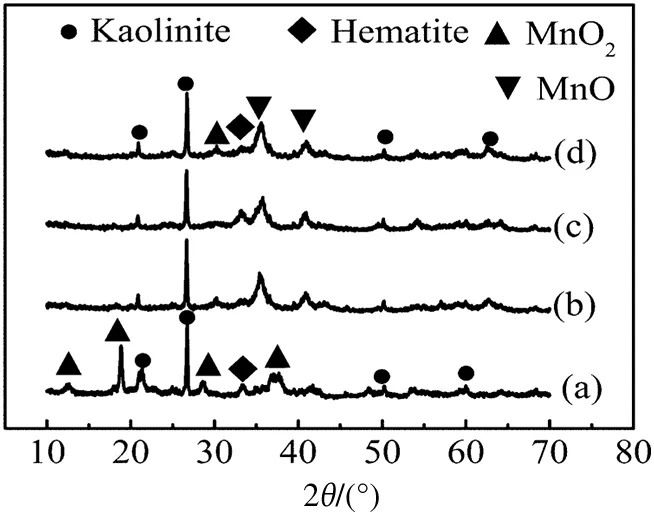
Fig.8.XRD patterns of pyrolusite(a),CP(b),HP(c),and LP(d).
Nomenclature
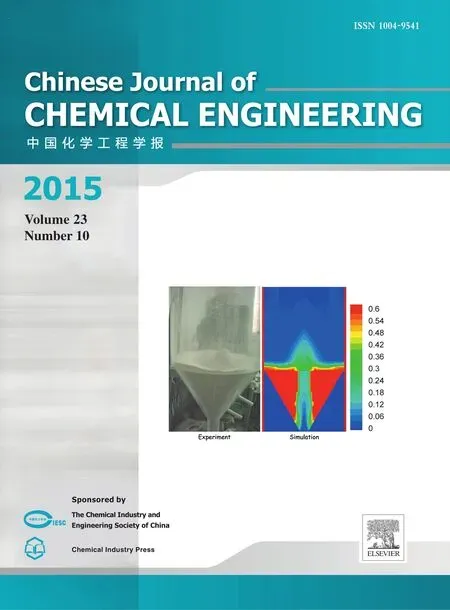 Chinese Journal of Chemical Engineering2015年10期
Chinese Journal of Chemical Engineering2015年10期
- Chinese Journal of Chemical Engineering的其它文章
- Synthesis and characterization of switchable ionic compound based on DBU,CH3OH,and CO2☆
- Preparation and simulation of a taro flavor☆
- Preparation and characterization of monodisperse zirconia spherical nanometer powder via lamellar liquid crystal template method
- Effect of PSA tin plating process on trace lead in tin coating☆
- Biological treatment of high wastewater using an ammonia-tolerant photosynthetic bacteria strain(ISASWR2014)☆
- Adsorption and degradation of nor floxacin by a novel molecular imprinting magnetic Fenton-like catalyst☆
